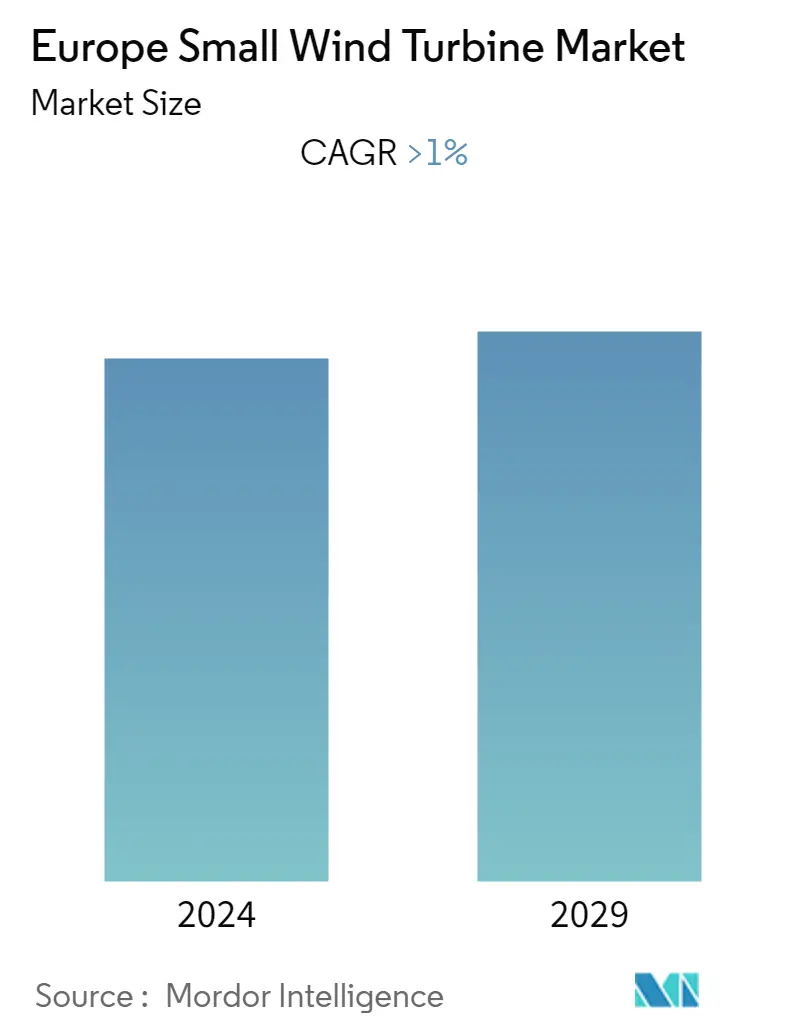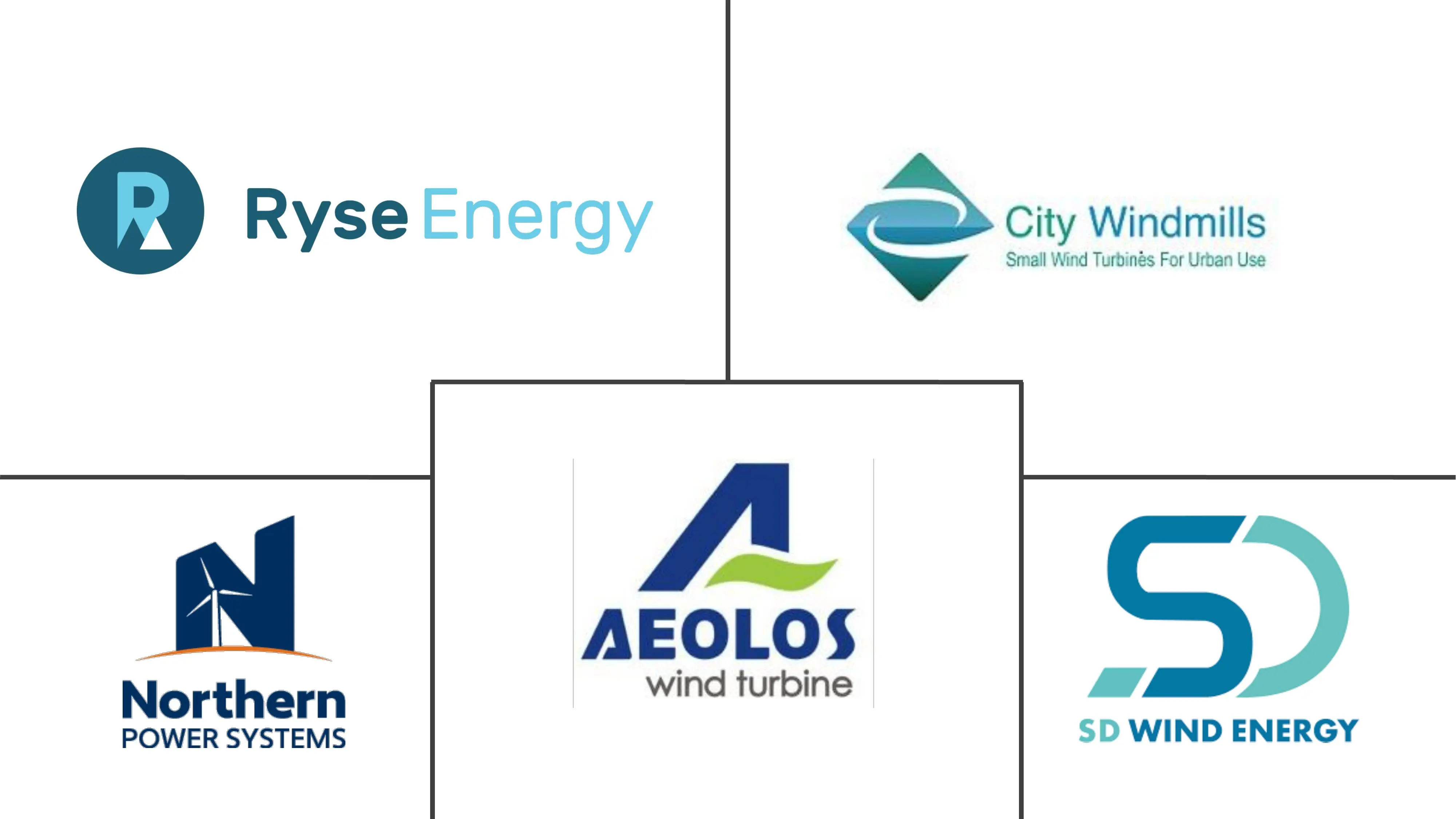Market Size of Europe Small Wind Turbine Industry

| Study Period | 2020 - 2029 |
| Base Year For Estimation | 2023 |
| Forecast Data Period | 2024 - 2029 |
| Historical Data Period | 2020 - 2022 |
| CAGR | 1.00 % |
| Market Concentration | Medium |
Major Players
*Disclaimer: Major Players sorted in no particular order |
Europe Small Wind Turbine Market Analysis
Europe's small wind energy market is projected to register a CAGR of over 1% during the forecast period.
The market was negatively impacted by COVID-19 in 2020. Presently, the market reached pre-pandemic levels.
- In the medium term, advancements in technology leading to wind turbine manufacturing cost reduction and increase in efficiency have been major factors for the growth of the small wind turbine market.
- On the other hand, the increasing adoption of alternative energy sources for small-scale renewable development, such as rooftop solar and small-scale bioenergy facilities, is expected to hinder the growth of the market during the forecast period.
- Nevertheless, the deployment of small wind turbines atop high-rise buildings has been investigated and implemented in limited capacities across many countries in Europe. This can redefine renewable energy generation and consumption in urban neighborhoods with a high carbon footprint, thus creating several opportunities for small wind turbines in the future.
- Germany is expected to dominate the market's growth, the government's initiative schemes for small wind systems development is anticipated to drive the market's growth.
Europe Small Wind Turbine Industry Segmentation
Small wind turbines, also known as micro wind turbines, are used for the microgeneration of electricity, as opposed to large commercial wind turbines, such as those found in wind farms, which generate large amounts of electricity. Unlike large wind turbines which use geared powertrains, small wind turbines usually use passive yaw systems. They have a direct drive generator and use a tail fin to point into the wind, whereas larger turbines use gearing systems that point actively into the wind.
Europe's small wind energy market is segmented by axis type and geography. By axis type, the market is segmented into horizontal-axis wind turbines and vertical-axis wind turbines. The report also covers the market size and forecasts for the small turbine market across major regions. For each segment, the market sizing and forecasts have been done based on revenue (USD million).
| Axis Type | |
| Horizontal Axis Wind Turbine | |
| Verticle Axis Wind Turbine |
| Geography | |
| Germany | |
| United Kingdom | |
| Italy | |
| Denmark | |
| Other Countries |
Europe Small Wind Turbine Market Size Summary
The small wind turbine market in Europe is experiencing a gradual recovery, having rebounded to pre-pandemic levels after the setbacks caused by COVID-19. The market is driven by technological advancements that have reduced manufacturing costs and increased efficiency, although the growth is somewhat tempered by the rising adoption of alternative energy sources like rooftop solar and small-scale bioenergy. Despite these challenges, the integration of small wind turbines in urban settings, such as atop high-rise buildings, presents new opportunities for renewable energy generation in areas with significant carbon footprints. Germany is poised to lead the market's expansion, supported by government initiatives aimed at developing small wind systems.
The market is characterized by a predominance of horizontal-axis wind turbines, which are favored for their technological and economic benefits, including ease of maintenance and enhanced power generation due to taller tower bases. While Germany has a substantial onshore wind generation capacity, its small wind turbine deployment lags behind countries like Denmark, Italy, and the United Kingdom, primarily due to lower feed-in tariffs compared to solar power. However, the German government's commitment to maintaining feed-in tariff programs provides a level of certainty for small wind turbine operators. The ability of small wind turbines to complement solar power plants, particularly in hybrid systems, is expected to drive market growth in the coming years. The European market remains moderately fragmented, with key players like Northern Power Systems Srl and SD Wind Energy Limited contributing to its development.
Europe Small Wind Turbine Market Size - Table of Contents
-
1. MARKET OVERVIEW
-
1.1 Introduction
-
1.2 Market Size and Demand Forecast in USD million, till 2027
-
1.3 Recent Trends and Developments
-
1.4 Government Policies and Regulations
-
1.5 Market Dynamics
-
1.5.1 Drivers
-
1.5.2 Restraints
-
-
1.6 Supply Chain Analysis
-
1.7 Industry Attractiveness - Porter's Five Forces Analysis
-
1.7.1 Bargaining Power of Suppliers
-
1.7.2 Bargaining Power of Consumers
-
1.7.3 Threat of New Entrants
-
1.7.4 Threat of Substitutes Products and Services
-
1.7.5 Intensity of Competitive Rivalry
-
-
-
2. MARKET SEGMENTATION
-
2.1 Axis Type
-
2.1.1 Horizontal Axis Wind Turbine
-
2.1.2 Verticle Axis Wind Turbine
-
-
2.2 Geography
-
2.2.1 Germany
-
2.2.2 United Kingdom
-
2.2.3 Italy
-
2.2.4 Denmark
-
2.2.5 Other Countries
-
-
Europe Small Wind Turbine Market Size FAQs
What is the current Europe Small Wind Turbine Market size?
The Europe Small Wind Turbine Market is projected to register a CAGR of greater than 1% during the forecast period (2024-2029)
Who are the key players in Europe Small Wind Turbine Market?
Northern Power Systems Srl, SD Wind Energy Limited, Aeolos Wind Energy Ltd, Ryse Energy and City Windmills Holdings PLC are the major companies operating in the Europe Small Wind Turbine Market.

